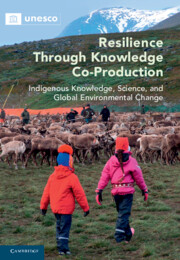 Resilience through Knowledge Co-Production
Resilience through Knowledge Co-Production Book contents
- Resilience through Knowledge Co-production
- Resilience through Knowledge Co-production
- Copyright page
- Contents
- Contributors
- Acknowledgements
- Introduction
- Part I From Practice to Principles
- 2 The Progression from Collaboration to Co-production: Case Studies from Alaska
- 3 Learning about Sea Ice from the Kifikmiut: A Decade of Ice Seasons at Wales, Alaska, 2006-2016
- 4 Shaping the Long View: Iñupiat Experts and Scientists Share Ocean Knowledge on Alaska’s North Slope
- 5 Indigenous Ice Dictionaries: Sharing Knowledge for a Changing World
- 6 Mapping Land Use with Sámi Reindeer Herders: Co-production in an Era of Climate Change
- 7 Sámi Herders’ Knowledge and Forestry: Ecological Restoration of Reindeer Lichen Pastures in Northern Sweden
- Part II Indigenous Perspectives on Environmental Change
- Part III Global Change and Indigenous Responses
- Epilogue
- Index
- References
4 - Shaping the Long View: Iñupiat Experts and Scientists Share Ocean Knowledge on Alaska’s North Slope
from Part I - From Practice to Principles
Published online by Cambridge University Press: 02 June 2022
- Resilience through Knowledge Co-production
- Resilience through Knowledge Co-production
- Copyright page
- Contents
- Contributors
- Acknowledgements
- Introduction
- Part I From Practice to Principles
- 2 The Progression from Collaboration to Co-production: Case Studies from Alaska
- 3 Learning about Sea Ice from the Kifikmiut: A Decade of Ice Seasons at Wales, Alaska, 2006-2016
- 4 Shaping the Long View: Iñupiat Experts and Scientists Share Ocean Knowledge on Alaska’s North Slope
- 5 Indigenous Ice Dictionaries: Sharing Knowledge for a Changing World
- 6 Mapping Land Use with Sámi Reindeer Herders: Co-production in an Era of Climate Change
- 7 Sámi Herders’ Knowledge and Forestry: Ecological Restoration of Reindeer Lichen Pastures in Northern Sweden
- Part II Indigenous Perspectives on Environmental Change
- Part III Global Change and Indigenous Responses
- Epilogue
- Index
- References
Summary
The Iñupiat Eskimo on Alaska’s North Slope live semi-traditional lives characterized by subsistence hunting and fishing and expansive natural travel networks. To the Iñupiat, the North Slope coastline is a social-cultural boundary between sea and land, marked by the location of past and current settlements, burial sites, family hunting locations, traditional places of refuge, and places immortalized through traditional stories. The coastline is where they observe, enter and exit the marine environment, and hence is interwoven throughout their local and traditional knowledge of the ocean and sea ice environment. Rarely, do local experts speak of ocean or ice features, or of a hunting story, without referring to a place on land. North Slope communities and their coastline are also staging areas for scientists who have adopted the Chukchi and Beaufort Seas as their natural laboratories. This chapter will explore a cross-section of the North Slope’s rich history of scientists working with local indigenous experts on coastal and marine topics, with specific attention to coastal emergency preparedness.
Keywords
- Type
- Chapter
- Information
- Resilience through Knowledge Co-ProductionIndigenous Knowledge, Science, and Global Environmental Change, pp. 67 - 92Publisher: Cambridge University PressPrint publication year: 2022


